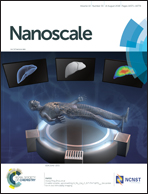A 3D graphene current collector boosts ultrahigh specific capacity in a highly uniform Prussian blue@graphene composite as a freestanding cathode for sodium ion batteries†
Abstract
For the first time, a uniform graphene aerogel (GA) supported Prussian blue (PB) nanocube structure was synthesized by fitting the nanocube into the GA with a specific pore size and employing it in a freestanding sodium ion battery cathodic electrode. In this electrode, the graphene framework not only offers mechanical support, but also plays the role of a binder-free current collector. The theoretical specific capacity of Prussian blue was exceeded with an ultrahigh specific capacity of 214 mA h g−1 at 0.5 C. With the help of the electronic double layer capacitance of the graphene framework, this ultrahigh value can be achieved. We studied the influence of the mass loading of the PB nanocube on the specific capacity, finding that the GA-induced freestanding electrode has the potential to load a maximum of 72 wt% of the PB nanocube. Furthermore, we separated the capacitance and the capacity of the electrode through kinetic analysis, and discovered that the GA-induced carbon collector contributed to a surface-controlled capacitance, which accounted for 55% of the total capacity.



 Please wait while we load your content...
Please wait while we load your content...